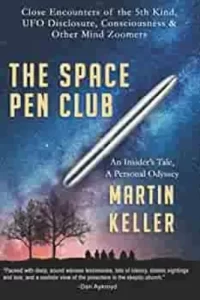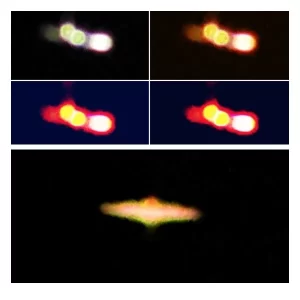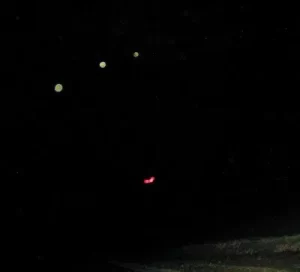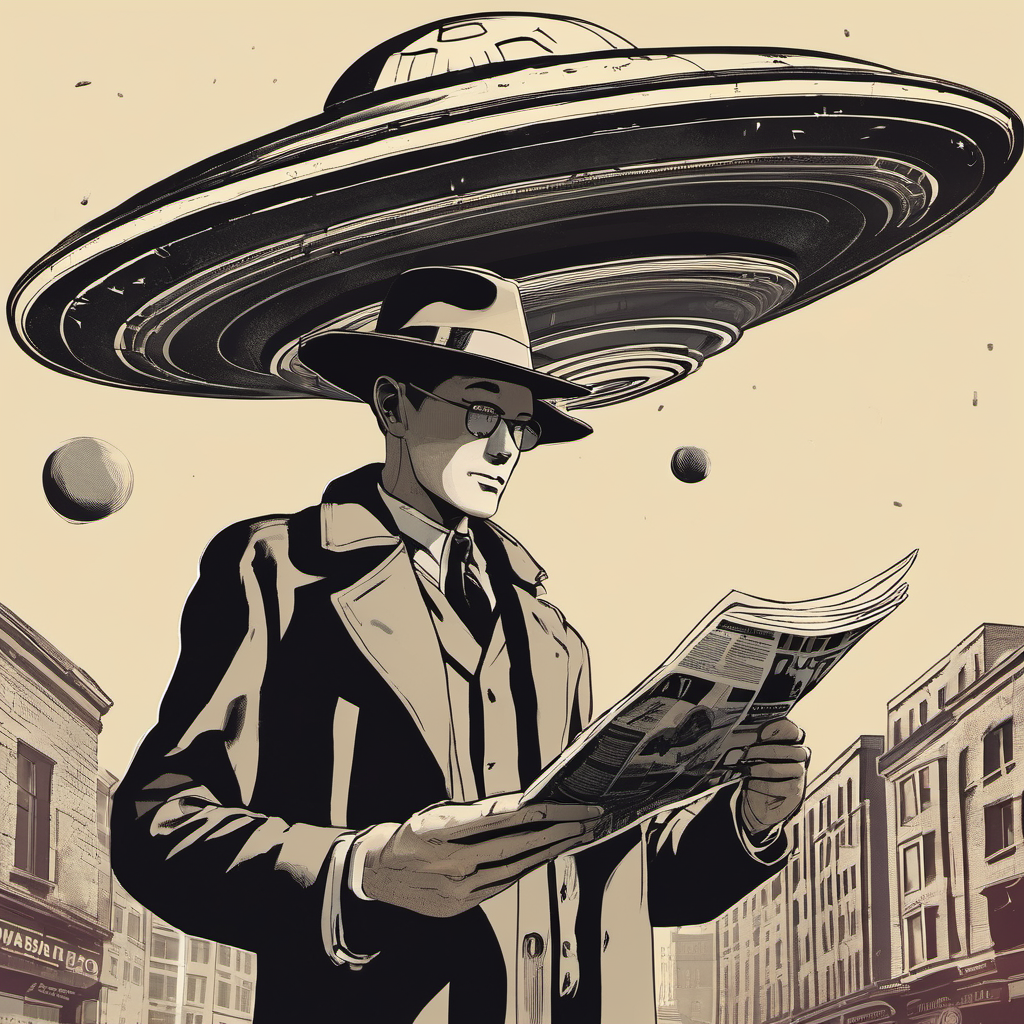 By KEN KORCZAK
By KEN KORCZAK
Sometimes groovy, always profound, a Minnesota author’s account of his encounter with the people and culture of ufology creates an American classic
Perhaps there’s no better line to describe the extraordinary journey of Martin Keller:
“What a Long Strange Trip It’s Been.”
Yes, that’s the title of an iconic compilation album by the Grateful Dead, and it’s doubly befitting Keller’s story. It’s a remarkable confluence of music, culture, politics, social issues, religion, science, philosophy — and UFOs.
Yea, verily, just when you thought there was nothing new under the sun in the realm of ufology — or at least in UFO literature — along comes Martin Keller.
In bringing out The Space Pen Club, he offers an astonishingly textured, multifaceted, nuanced and variegated take on “The Phenomenon” by taking us inside the intensely weird milieu of flying saucers, aliens, orbs, precognitive dreams, bizarre visitations and the people who are obsessed with them.
BACKGROUND
After growing up in a small North Dakota town and then nailing down an English degree at Minnesota’s St. John’s University, Keller quickly made a name for himself as a pop culture journalist.

He covered the surprisingly fertile Twin Cities music scene of the early 1980s. From it sprang the likes of Prince, Soul Asylum, the Replacements, The Jayhawks, and let’s not forget Hüsker Dü.
Keller had a knack for getting inside and behind the scenes by getting to know artists personally. He landed an interview with Prince when The Purple One was just 17 but already on the cusp of greatness. Keller interviewed and was on friendly terms with Minnesotan and global folk-rock demigod, Bob Dylan.
He formed lifetime friendships with other deeply consequential but lesser-known names who contributed significantly to the legacy of rock, such as Pat Hayes, founder of The Lamont Cranston Band.
Keller wrote for all hip alternative publications, both as a freelancer but also as a staff member for City Pages and Twin Cities Reader. To build a “real” media-centric career, however, he later got into public relations. After stints with a couple of local firms, he established his own successful Minneapolis PR outfit, Media Savant Communications.
It was partially through the public relations oeuvre and his skills as a journalist that Keller intersected with the weird world of UFOs. It thrust him, as he likes to say — “down the rabbit hole” — of what he still likes to call — “the UFO ghetto” — a term coined by ufologist Steven M. Greer — and he comes into the story next.
HOW IT STARTED
It was in 1991 that a friend of Keller’s had just returned from Wyoming.
As they chatted and caught up, his friend told Keller his trip out west was to participate in a group gathering called a CE-5 session sponsored by a group called CSETI.
CSETI stands for Center for the Study of Extraterrestrial Intelligence. It was founded in 1990 by an Ashland, North Carolina, emergency room medical doctor. That would be the now famous and (to many) infamous Steven M. Greer M.D.
CE-5 is “Close Encounter of the Fifth Kind” — an extension of Dr. J. Allan Hynek’s “Close Encounter of the 1st, 2nd and 3rd Kind” The 4th Kind was later added by famous ufologist Dr. Jacques Vallee. He said the 4th Kind represents “cases when witnesses experienced a transformation of their sense of reality.”
Well, Dr. Greer envisioned 5th Kind encounters that can be defined as a kind of voluntary controlled contact between humans and ETs.

In this case, people strive to proactively seek contact with “The Others” through a process that combines Transcendental Meditation (or some form thereof) along with certain kinds of light show displays and playing recordings of certain UFO sounds. This, in turn, was meant to attract ET out of the sky for not just sightings of UFOs, but hopefully, even a physical UFO landing would entail a bona fide human-to-alien meet and greet!
All this spacey catnip tweaked Keller’s alternative journalism jones. He smelled a heady counter-culture story and so gave the good doctor a call. Understanding he needed a higher media profile to grow his organization, Greer agreed to an interview.
Thus, Keller jetted off to California for a personal chat with the remarkable, mercurial and soon-to-be ever-increasingly controversial Dr. Greer. Little did Keller know, this nascent meet-up with the CSETI founder would inject him for the next seven years (or so) into a milieu that, at times, felt like being transported inside the narrative of a Philip K. Dick science fiction novel.
WHAT HAPPENED
Although Keller wrote a CSETI story he felt worthy of the major leagues, it was a bust.
He pitched it to A-list publications like Vanity Fair and Rolling Stone, but none bit. (Note: Keller would later score a front-page story for Rolling Stone about the musical influences of Fox network’s top-rated X-Files show).
It wasn’t a total loss, however. Apparently, there was some chemistry between Keller, Greer and his team. Keller offered to put his studied fourth estate chops to work for CSETI “on the other side of the table” as a PR man and media relations specialist.
Dr. Greer agreed, but only if Keller worked pro bono. Just his travel, lodging and miscellaneous expenses would be paid when he engaged in group activities. The latter included participating in CE-5 sessions in exotic locations — such as remote desert regions in Arizona and areas around the base of Mexico’s magnificent volcano, Mt. Popocatépetl, a well-known UFO hotspot.
Yes, Keller experienced some incidents of UFO or perhaps more often vaguely-like UFO activity during the CE-5s he attended, but — ironically — the truly significant high strangeness of his story (in my view) doesn’t stem from all-night meditation alien psychic-connection sessions under the stars.
AS IT TURNS OUT …
Martin Keller is what might fairly be called “an experiencer” in UFO lingo.
As it turns out, the allure of an intriguing story may have been just the overt impetus behind his decision to seek out Greer and CSETI for a story.
Keller has been an experiencer off and on through much of his life. His first encounter occurred when he was a high school student in Dickinson, North Dakota.
One cold February night during a break at a high school basketball game, he and a few friends stepped outside the school and saw a no-brainer up-close UFO cruising out over the frosty winter western plains of the Peace Garden State.
He had another sighting as well. I won’t tell you about it because I don’t want to give too much away.
But he also experienced a series of bizarre paranormal events in the months just prior to when he elected to make contact with CESTI. This included vivid precognitive dreams and certain strange events inside his bedroom and night — which I will not tell you about because that’s giving too much away too. Suffice it to say that the implication is that larger forces were at work — as if some manner of overarching cosmic consciousness decided it was time to give Marty a nudge.

“Something” may have been prompting him to step outside the seductive entrapment of empirical scientific materialism reality most of humanity is ensnared within.
But it seems an internal struggle for Keller. He frequently intimates that he’s ever keen to escape “the UFO ghetto.” It’s as if he desires to be a “normal” open-minded skeptic, but circumstances beyond his control have other plans for him.
In a moment of poignant reflection, Keller tells of attending a performance of Handel’s Messiah at the magnificent Cathedral of St. Paul that overlooks the Minnesota capital city and Mississippi River. Gazing up at the dazzling stained-glass windows of the cathedral, he writes:
“… staring as hard at them as I stared at my own inner life, I felt a comfort zone of nostalgic innocence wash over me … hoping and praying the world was the way they said it was in church, at home and in school. Praying that it was all real, black-and-white and simple. Praying it would stay that way as time wore on, but knowing deep inside, that just wasn’t going to happen.”
WHAT IS THE SPACE PEN CLUB?
My review is already waxing overlong, but I can’t leave without a word about the eponymous title, The Space Pen Club.
While a student at St. John’s University — a school established by Benedictine Monks in Collegeville, Minnesota, and still home to one of the largest Catholic monasteries in the Western Hemisphere — Keller was a seminal member of a wacky-super-groovy-hippy-counter-culture kind of club that took to calling itself the Space Pen Club.
The inspiration for the name was a fascination with the Fisher Space Pen invented by Paul C Fisher in 1967. (Incidentally, 1967 was the Summer of Love.) The Space Pen wields a sealed and pressurized ink cartridge, ostensibly to produce a pen that can reliably write in the zero-gravity environment of outer space. In fact, it can write damn near anywhere, such as underwater, or upside down if you wanted to scribble poetry while lying in bed.
(Note: legend has it that Soviet cosmonauts guffawed at this ostentation. To write while in space, they just used pencils).
Anyway, the Space Pen commands the title of the book because Keller uses his college club as a touchstone around which to weave his story.
Let’s call it a mythological-archetypical-avatar that binds multiple narratives of disparate subjects, including people, their motivations, dreams, foibles, aspirations, culture, society, technology and more.
The notion of the Space Pen Club is a kind of alchemical plot artifice that Keller draws upon to ground his consciousness — and to hearken upon as a creative engine that helps him navigate his way through the complex twists and turns of all that life dished out over the decades.
Readers will find this intricately interwoven, recurring Space Pen Club motif mesmerizing.
FINALLY — A ‘UFO BOOK’ LIKE NO OTHER
Now, how should I put this?
In my view, with The Space Pen Club, Keller does for the UFO genre what Jack Kerouac did for the road trip.
It does what Hunter S. Thompson did for journalism in writing his epic 1970 Kentucky Derby article for Scanlon’s Monthly and thereby inventing Gonzo journalism.
It does what Stephen Davis did for the legacy of Led Zeppelin when he brought out his now classic 1985 book, Hammer of the Gods.
I mean really, and I hope I am not waxing overwrought, but I can’t think of another book about “The Phenomenon” that intersects with so many facets of human culture — social, political, historical, theological, sociological, psychological, scientific and — yes — ufological.
The Space Pen Club is far more than “a UFO book.” It’s a classic piece of literary Americana. It’s art.
ADDITIONAL RESOURCE:
For ongoing discussion on UFOs and ancillary issues, The Space Pen Club lives on in cyberspace. I checked out its blog, for example, and can say there are some decent UFO articles there. Find it here: THE SPACE PEN CLUB.
NOTE: For more in-depth book review on UFOs & other paranormal topics, please see: KEN-0N-MEDIUM.
